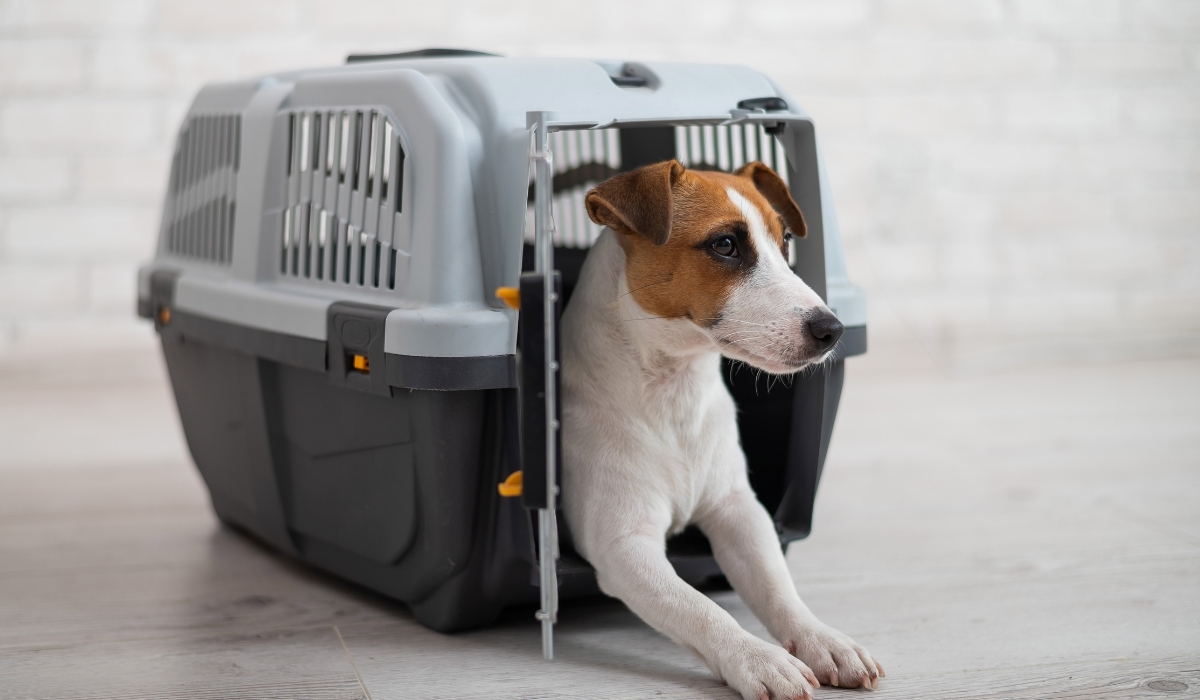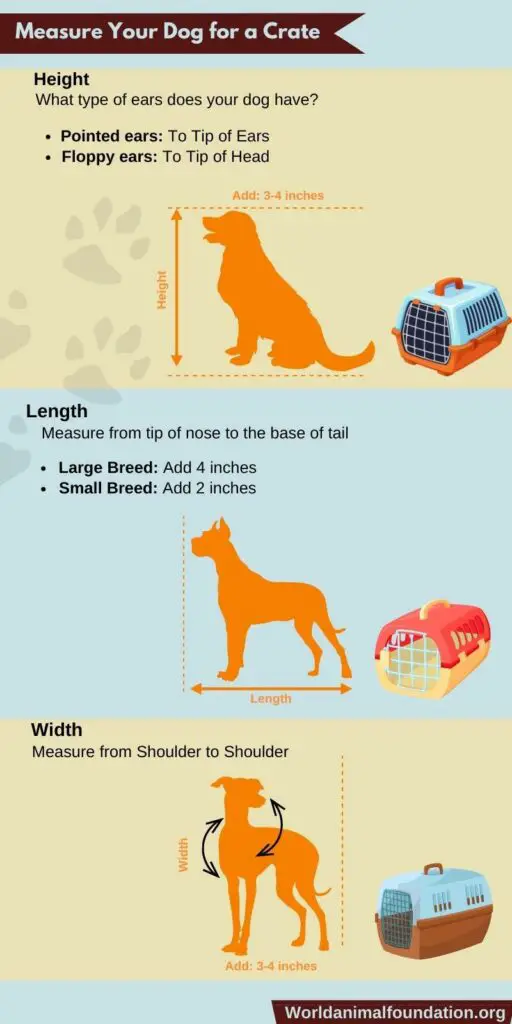Choosing the right crate size for your dog is crucial for their comfort and well-being. A crate that’s too small restricts movement and can cause anxiety, while one that’s too large can undermine house-training efforts. Our Dog Crate Size Calculator takes the guesswork out of finding the perfect fit. Simply input your dog’s measurements, and our calculator will recommend an appropriate crate size, ensuring a comfortable and secure den for your furry friend. Say goodbye to crate-sizing stress and hello to a happy, relaxed pup!
Our dog crate size calculator is the perfect tool to help you find the ideal crate size for your furry friend. Simply input your dog’s measurements, and our crate calculator will provide you with the right crate dimensions for comfort and security.
Say goodbye to guesswork and make crate selection a breeze with our easy-to-use crate calculator.
Dog Crate Size Calculator
Dog’s Height (inches):
Dog’s Length (inches):
Breed Size:
Small
Medium
Large
Calculate
.commonpostlink {
display: none !important;
}
.main-feature-img {
display: none !important;
}
/* Custom Styles */
.custom-container {
max-width: 600px;
margin: 0 auto;
padding: 20px;
border: 1px solid #ccc;
border-radius: 5px;
background-color: #F0F4F9;
margin-bottom: 20px;
}
.custom-heading {
text-align: center;
margin-bottom: 20px;
}
.custom-input-container {
text-align: center;
margin-bottom: 15px;
}
.custom-label {
display: block;
font-weight: bold;
margin-bottom: 5px;
}
.custom-input,
.custom-select {
width: 50%;
padding: 10px;
border-radius: 15px;
border: 2px solid #ccc;
font-size: 18px;
font-weight: bold;
color: #A0522D;
transition: border 0.3s ease, box-shadow 0.3s ease;
box-shadow: 0 2px 5px rgba(0, 0, 0, 0.1);
background-color: white;
margin: 10px auto; /* Centers the input and adds margin to top and bottom */
display: block; /* Makes the input a block-level element */
}
.breed-container {
margin-top: 15px;
}
.custom-button {
display: block;
margin: 20px auto;
padding: 15px 40px;
background-color: #41200B;
color: #ffffff;
border: none;
cursor: pointer;
font-size: 16px;
border-radius: 5px;
}
.custom-button:hover {
background-color: #5D3322;
}
.custom-hidden {
display: none;
justify-content: center;
align-items: center;
}
.custom-result-container {
display: flex;
justify-content: center;
align-items: center;
width: 100%;
}
.custom-result {
font-weight: bold;
display: inline-block;
background-color: #41200B;
color: #fff;
padding: 10px;
border-radius: 5px;
width: 100%;
}
.error {
background-color: #FF0000;
color: #fff;
text-align: center;
font-weight: bold;
padding: 10px;
margin-top: 20px;
}
const crateSizes = {
small: { height: 2, length: 2 },
medium: { height: 3, length: 3 },
large: { height: 4, length: 4 }
};
function calculateCrateSize() {
const dogHeight = parseFloat(document.getElementById(“dogHeight”).value);
const dogLength = parseFloat(document.getElementById(“dogLength”).value);
const breedSize = document.getElementById(“breedSize”).value;
if (isNaN(dogHeight) || isNaN(dogLength) || dogHeight <= 0 || dogLength <= 0) {
showError(“Please enter valid values for the dog’s height and length.”);
return;
}
if (!(breedSize in crateSizes)) {
showError(“Please select a valid breed size.”);
return;
}
const recommendedCrateHeight = dogHeight + crateSizes[breedSize].height;
const recommendedCrateLength = dogLength + crateSizes[breedSize].length;
const resultElement = document.getElementById(“result”);
resultElement.textContent = `Recommended Crate Height: ${recommendedCrateHeight} inches, Length: ${recommendedCrateLength} inches`;
document.getElementById(“result-container”).classList.remove(“custom-hidden”);
document.getElementById(“error”).classList.add(“custom-hidden”);
}
function showError(message) {
const errorElement = document.getElementById(“error”);
errorElement.textContent = message;
document.getElementById(“result-container”).classList.add(“custom-hidden”);
errorElement.classList.remove(“custom-hidden”);
}
Need of Getting a Crate
A dog kennel is a portable enclosed structure made of various materials like wire, plastic, or fabric, used to provide a designated area where dogs can rest, sleep, or stay confined for short periods.
A dog crate can enhance your companionship and living experience even if you own a perfectly well-behaved pooch. It is an essential dog accessory as it helps in providing a comfortable space for your furry companion.
Crates offer numerous benefits, such as crates:
- Serve as a specified area where your dog can retreat to when guests come over
- Aid in-house potty training as dogs instinctively avoid soiling their sleeping area
- Provide a familiar and safe space when traveling or during visits to the vet
- Deter destructive behavior when you can’t directly supervise your dog
- Serve as a calming retreat and help them cope with separation anxiety
However, it’s essential to crate-train your dog gradually, using positive reinforcement to create positive associations. Never use the dog crate as punishment, and ensure your dog has enough space, comfort, and regular opportunities for exercise and social interaction outside the crate.
Each dog’s needs may vary, so it’s essential to tailor crate use to your dog’s temperament and requirements.
How to Take Dog Measurements for Crate
Taking accurate measurements of your dog is essential to ensure you choose the right-sized crate that provides comfort and security. Here’s a step-by-step guide to measuring your dog for a crate:
1. Length: Measure your dog from the tip of their nose to the base of their tail. Add 2-4 inches to this measurement to determine the minimum length of the crate.
2. Height: Measure your dog in a sitting position, from the ground to the highest point of your pup, like the top of the head or ears (whichever is higher). Add 3-4 inches to this measurement to determine the minimum height of the crate.
3. Width: Measure your dog from shoulder to shoulder or the width of the widest point. Add 2-4 inches to this measurement to determine the minimum crate size.
Always follow the manufacturer’s guidelines and size recommendations for the specific dog crate you are considering. A properly sized indoor dog kennel will provide your dog with a cozy and snug space, promoting positive associations with crate time and making it a valuable tool for crate training and relaxation.
General Insight to Dog Crate Size Calculator
A dog crate size calculator is a helpful tool that assists pet owners in determining the appropriate crate size for their pups based on specific measurements. The crate calculator estimates the ideal crate size by inputting the dog’s height, length, and width.
The crate calculator ensures that the chosen crate provides sufficient space for the dog to stand, turn around, and lie down comfortably. It also considers the dog’s growth if they are still young and growing.
Using a dog crate size calculator is essential for selecting a dog kennel that promotes a positive and comfortable environment for the dog. A crate that is too small can cause discomfort, stress, and limit movement, while a crate that is too large might not provide the desired sense of security.
What Should be the Ideal Size for a Crate
The ideal size for a crate depends on the size and breed of your dog. As discussed earlier, a properly sized crate should allow your dog to stand up without crouching, turn around comfortably, and lie down with their paws extended.
Selecting the right crate is essential for your dog’s comfort. Here are various crate sizes with compatible dog breeds:
1. Extra Small Dog Crate: Fits dogs 18-22 inches long, 10 lbs or less. Suitable for Chihuahua, Maltese, Papillon, Pomeranian, Shih Tzu, and Yorkshire Terrier.
2. Small Dog Crate: Ideal for dogs 24 inches long, 10-25 lbs. Fits Bichon Frise, Boston Terrier, Cavalier King Charles Spaniel, Dachshund, Jack Russell Terrier, and more.
3. Medium Dog Crate: For dogs 30 inches long, 25-40 lbs. Suitable for Beagle, Cocker Spaniel, French Bulldog, Shetland Sheepdog, and others.
4. Large Dog Crate: Fits dogs 36 inches long, 40-70 lbs. Ideal for American Pit Bull Terrier, Basset Hound, Border Collie, Siberian Husky, and more.
5. Extra Large Dog Crate: For dogs 42 inches long, 70-90 lbs. Good for Boxers, Labrador Retrievers, Golden Retrievers, Greyhounds, and others.
6. XXL Dog Crate: Fits dogs 48 inches long, 90 lbs or more. Suitable for Great Dane, Mastiff, Rottweiler, Saint Bernard, and more. Consider the size and weight of your dog when choosing the crate
If you have a puppy, consider their potential growth and opt for a crate with dividers that can be adjusted as they grow. If you want to learn how big your dog will likely be once it’s grown, use our puppy weight calculator.
Select the crate type (wire, plastic, soft-sided) based on your dog’s needs, temperament, and the intended use of the crate (e.g., travel crate, housetraining, or indoor confinement).
FAQs
What kennel size is appropriate for a 30lbs dog?
The appropriate dog kennel size for a 30-pound dog would typically be a medium-sized crate.
The specific dimensions of a medium-sized crate can vary between different manufacturers, but it is generally suitable for pups around 30 pounds. As a reference, a medium crate might have dimensions around 30 inches in length, 20 inches in width, and 22 inches in height.
Measuring your dog’s length, height, and width accurately is important to ensure the crate’s size is appropriate for your furry friend. Always refer to the manufacturer’s size recommendations for further information.
What should be an ideal size for a puppy crate?
Measure your puppy’s length from the tip of their nose to the base of their tail. Measure your puppy’s height from the top of their head to the ground and from elbow joint to the floor. Measure the widest point between the shoulders. Add a few inches to both measurements to ensure the crate offers enough space for your puppy’s growth.
When selecting a crate for your puppy, opt for an expandable crate that accommodates your dog’s breed’s typical adult size. These crates have a divider that allows you to adjust the interior space as your puppy grows.
This design ensures your puppy has enough room for comfort while promoting successful house training at night. Modify the divider to provide the appropriate space as your puppy matures, making the crate a versatile and long-lasting solution for your furry companion.
Conclusion
Unlike a dog kennel, which serves as a playpen, your dog’s crate doesn’t require excessive space for frolicking. However, it should still provide enough room for comfort, ensuring it’s not too cramped.
The ideal crate size strikes a balance, giving your dog a cozy and secure environment while promoting proper rest and relaxation. Remember, the crate should be spacious enough for them to move comfortably but not so large that it hinders successful housetraining or makes them feel insecure.
Ensuring the right-sized crate will create a cozy and inviting space for your dog, making crate time a positive and enjoyable experience. Use our crate calculator now to provide your beloved pet with the perfect fit!
Choosing the right crate size is crucial for your dog’s comfort and well-being. A crate that’s too small restricts movement and can cause anxiety, while one that’s too large can encourage accidents. Using a dog crate size calculator ensures a perfect fit, allowing your dog to stand, turn around, sit, and lie down comfortably. By accurately measuring your dog and using the calculator, you provide a safe and secure den-like space that promotes relaxation, aids in housetraining, and provides a comfortable retreat for your furry friend.


